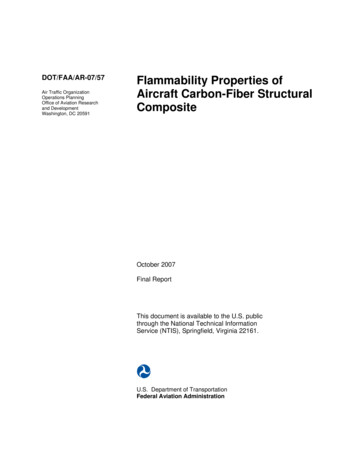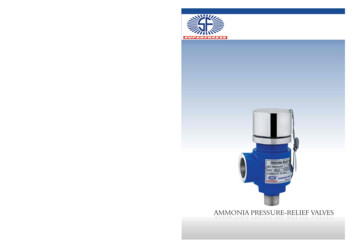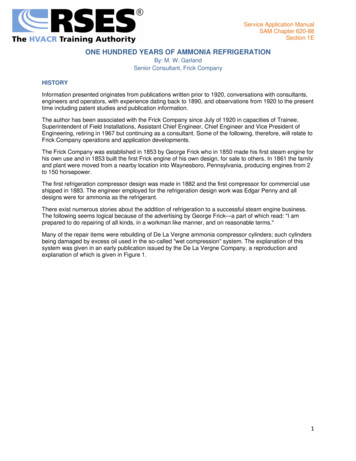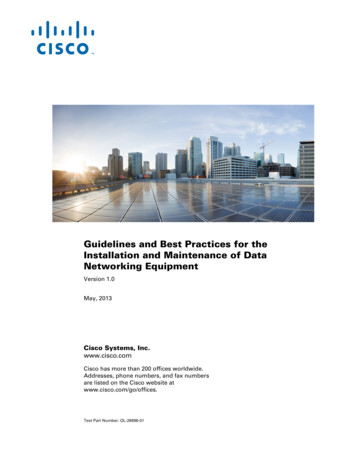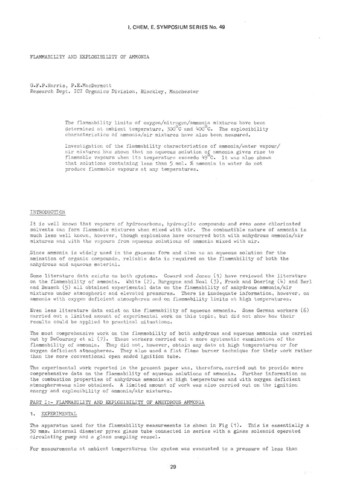
Transcription
I. CHEM. E. SYMPOSIUM SERIES No. 49FLAMMABILITY AND EXPLOSIBILITY OF AMMONIAG.F.P.Harris, P.E.MacDermottResearch Dept. ICI Organics Division, Blackley, ManchesterThe flammability limits of oxygen/nitrogen/ammonia mixtures have beendetermined at ambient temperature, 300o C and 400o C. The explosibilitycharacteristics of ammonia/air mixtures have also been measured.Investigation of the flammability characteristics of ammonia/water vapour/air mixtures has shown that no aqueous solution of ammonia gives rise toflammable vapours when its temperature exceeds 49o C. It was also shownthat solutions containing less than 5 mol. % ammonia in water do notproduce flammable vapours at any temperatures.INTRODUCTIONIt is well known that vapours of hydrocarbons, hydroxylic compounds and even some chlorinatedsolvents can form flammable mixtures when mixed with air. The combustible nature of ammonia ismuch less well known, however, though explosions have occurred both with anhydrous ammonia/airmixtures and with the vapours from aqueous solutions of ammonia mixed with air.Since ammonia is widely used in the gaseous form and also as an aqueous solution for theamination of organic compounds, reliable data is required on the flammability of both theanhydrous and aqueous material.Some literature data exists on both systems. Coward and Jones (l) have reviewed the literatureon the flammability of ammonia. White (2), Burgoyne and Neal (3), Frank and Doering (4) and Berland Bausch (5) all obtained experimental data on the flammability of anhydrous ammonia/airmixtures under atmospheric and elevated pressures. There is inadequate information, however, onammonia with oxygen deficient atmospheres and on flammability limits at high temperatures.Even less literature data exist on the flammability of aqueous ammonia. Some German workers (6)carried out a limited amount of experimental work on this topic, but did not show how theirresults could be applied to practical situations.The most comprehensive work on the flammability of both anhydrous and aqueous ammonia was carriedout by DeCoursey et al (7). These workers carried out a more systematic examination of theflammability of ammonia. They did not, however, obtain any data at high temperatures or foroxygen deficient atmospheres. They also used a flat flame burner technique for their work ratherthan the more conventional open ended ignition tube.The experimental work reported in the present paper was, therefore, carried out to provide morecomprehensive data on the flammability of aqueous solutions of ammonia. Further information onthe combustion properties of anhydrous ammonia at high temperatures and with oxygen deficientatmosphereswas also obtained. A limited amount of work was also carried out on the ignitionenergy and explosibility of ammonia/air mixtures.PART I:- FLAMMABILITY AND EXPLOSIBILITY OF ANHYDROUS AMMONIA1. EXPERIMENTALThe apparatus used for the flammability measurements is shown in Fig (1). This is essentially a50 mms. internal diameter pyrex glass tube connected in series with a glass solenoid operatedcirculating pump and a glass sampling vessel.For measurements at ambient temperatures the system was evacuated to a pressure of less than29
I. CHEM.-E. SYMPOSIUM SERIES No. 492 torr. and ammonia admitted to the required pressure. The solenoid pump was started and thedesired premixed supporting atmosphere of oxygen and nitrogen let in until atmospheric pressurewas reached. After 20 minutes circulation the pump was switched off and the sampling vesselremoved for analysis. The ground glass plate at the base of the tube was removed and a 1.5 Jouleinductance spark passed between the electrodes. The mixture under test was considered to beflammable if a flame travelled away from the electrodes for the full length of the tube.A similar procedure was adopted for measurements at elevated temperatures except that the ammonia/oxygen/nitrogen mixtures were prepared in a heated 6 litre stainless steel bomb at aboveatmospheric pressure. The heated mixture was then analysed and admitted to the evacuated ignitiontube. The ignition tube was surrounded by an electrically wound jacket and any passage of flamealong the tube on sparking as observed through slits in the jacket.A few experiments were carried out on the explosibility of ammonia mixtures. In this work thedesired mixtures were prepared in the 6 litre bomb, ignited by a hot resistance wire at the centreof the bomb and the maximum explosion pressure and rates of pressure rise measured by acapacitance transducer sited in the vessel wall.Check experiments were carried out in both the stainless steel bomb and the 50 mm. diameter glasstube to see if ammonia was lost by oxidation before the mixture could be ignited. In both casesa maximum of 4% of the ammonia was lost at the highest temperature used (400o C) and the longestresidence time in the apparatus.2.2.1RESULTSFlammability Limit MeasurementsFlammability limit measurements were carried out at three temperatures - ambient, 500 C and 400 Cwith supporting atmospheres containing from 21% oxygen (air) down to 11.0% oxygen. All theseexperiments were carried out under atmospheric pressure. The results of this work are shown inFig. (2), where vol. % ammonia in the mixture is plotted against vol. % oxygen in the supportingatmosphere.The data in Fig. (2) show that ammonia behaves in a similar manner to hydrocarbon vapours and theflammability limits widen as temperature increases. Thus the limits for ammonia in air increasefrom 16.6-27.2% ammonia in the mixture at ambient temperatures to 13.1-34.3% at 300o C and 11.237.1% at 400oC.Compilations of data such as Coward and Jones (1) and Zabetakis (8) give lower limits for ammoniaand air at ambient temperatures between 15.O and 17-1 vol % and upper limits between 26.4 and 28.0vol %. None of these measurements were carried out with an open ended tube (i.e. at constantpressure), which is the preferred method. The influence of temperature on the flammability limithas been measured by White (2) and more recently by Rolingson (9). Their results show the sameincrease in the flammable range with temperature increase as found in the present work. All thesehigher temperature flammability limit data are plotted in Fig. (3) together with the more recentliterature data of De Coursey et al (7) obtained at ambient temperature using a flat flame burnertechnique.The value of the lower flammability limit at ambient temperature found in the present work agreeswell with the flat flame burner determinations (7) and with other literature data. Agreement isnot as good for the upper limit. This limit is always practically more difficult to measure thanthe lower limit and both limits are influenced to some extent by the strength of the ignitionsource. In the experience of the authors powerful ignition sources e.g. gun cotton tend to give anunrealistic widening of the limits, particularly if they are measured in a closed vessel.One further parameter shown in Fig.(2) is of importance for application to chemical plant design.This is the minimum oxygen concentration in the supporting atmosphere, below which no ammoniacontaining mixture will burn. Examination of Fig. (2) shows that this decreases from 17 vol. %oxygen at ambient temperature to 12.8% at 300o C and 11.0% at 400o C. These minimum oxygenconcentrations are plotted against temperature in Fig. (4) together with similar data obtainedunder elevated pressure by Buckley and Husa (10). As can be seen all the data lie on a goodstraight line enabling extrapolation to temperatures of 500-600 C (where experimental work isdifficult to be carried out with reasonable accuracy).2.2Explosibility MeasurementsThe measurements of the explosibility of ammonia were carried out in a 6 litre stainless steel bombwith ammonia containing mixtures initially under atmospheric pressure. Explosion pressures weremeasured at the three temperatures - ambient, 300 C and 4OOoC used in the flammability limit work,but the only supporting atmosphere investigated was air.30
I. CHEM. E. SYMPOSIUM SERIES No. 49The results showed the same characteristics as measurements made with hydrocarbon/air mixtures.Both the maximum explosion pressure and rates of pressure rise gave a maximum value for anammonia/air mixture with a composition close to the stoichiometric. Tabie (1) shows the maximumvalues of these 3 parameters together with the maximum explosion pressure and rates of pressurerise for the most explosive mixture of a typical hydrocarbon (pentane) in the same 6 litre bomb.TABLE (1):- Explosibility of Ammonia(most explosive ammonia/air mixture)mTemperature(oc)Av. Rate PressRise(bars/sec.)Max. 8.9540.67Max. Rate PressRise(bars/sec.)17.9266.1784.783.0 mol % Pentane in airAmbient8.13189.5448.0These results show that explosion pressure decreases with increase in temperature as would beexpected for explosions in a vessel with a constant volume. This temperature effect has alreadybeen seen in the work of Crouch et al (11). The maximum explosion pressure for ammonia is alsoappreciably less than for a typical hydrocarbon - pentane.The rates of pressure rise both increase with increase in temperature and, in line with thereduced maximum explosion pressure, the rates of pressure rise are considerably less than those forpentane at ambient temperature.This rexplosibility data indicated that when ammonia/air mixtures are ignited they burn much moreslowly than hydrocarbon/air mixtures. It was of interest to see whether ammonia containingmixtures were also less easy to ignite than hydrocarbon mixtures.2.3Ease of Ignition of AmmoniaMeasurement of ignition energy presents considerable practical difficulties - nature of spark(capacitance or inductance), geometry of electrodes, electrode gap etc. The limited amount ofliterature on this subject Buckley and Husa (10) and Magison (12) show considerable discrepanciesin the measured values of ammonia ignition energies, probably because of the practicaldifficulties listed above.A few measurements were, however, carried out using first an inductive spark and then acapacitance spark. The results obtained with these two sparks for the most explosive ammonia/airmixture are given in Table (2) together with the literature data.31
I. CHEM.E. SYMPOSIUM SERIES No. 49TABLE (2):- Minimum Ignition Energies of AmmoniaSourceofDataExplosiveMixtureType ance(Henrys)MinimumIgnitionEnergy(mJ)This 951.10.0951.1 9017060406801.21.0Examination of Table (2) shows that the data obtained with inductance sparks agrees reasonablywell with that of Magison, but the measured ignition energy was higher with the capacitance spark.The ignition energies given by Magison and those obtained in the present work are considerablylower than the data of Buckley and . Husa. The most important conclusion from the data in Table (2)is that mixtures of ammonia and air are appreciably more difficult to ignite than those of atypical hydrocarbon, pentane, and air (40-170 mJ vs 1.0-1.2 mJ).3.CONCLUSIONSThe flammability data for anhydrous ammonia/oxygen/nitrogen mixtures obtained in the present workprovides adequate information for plant design purposes for a range of supporting atmospheres andtemperatures up to HOO C.Agreement with other published data is good, at least for the lower flammability limit. Somedoubt still exists about the upper flammability limit, but the data presented are from experimentsin an open tube using a realistic source of ignition (high energy spark), where flames were seento travel an appreciable distance from the source of ignition.Explosibility measurements show that ammonia/air mixtures are significantly less explosive than atypical hydrocarbon, pentane, mixed with air. A few measurements on ease of ignition showed thatthe most explosive mixture of ammonia and air was much more difficult to ignite than thecorresponding pentane/air mixture.PART (2):- FLAMMABILITY OF AQUEOUS AMMONIA1.EXPERIMENTALThe flammability limits of ammonia/air/water vapour mixtures were determined in the apparatus usedfor the work on anhydrous ammonia (see Fig. (1)). The equipment was again evacuated to less than2 torr. and the required amounts of ammonia and water vapour admitted in turn. Air was thenadmitted until the pressure reached atmospheric and the ammonia, water vapour and air mixed bymeans of the solenoid pump.In each experiment a sample of the mixture under test was taken and analysed for ammonia andwater vapour content. A 1.5 Joule inductance spark was again used to ignite the mixture and theground glass plate at the base of the ignition tube was removed before ignition.All the experiments on ammonia/water vapour/air mixtures were carried out at one temperature, 80 C,to prevent condensation of water vapour inside the equipment. For this purpose all the equipment,solenoid pump and sample tube included was enclosed in an oven.2.RESULTSThe results of these experiments are shown in Fig.(5), where vol. % oxygen in the mixture undertest is plotted against vol. % ammonia in the same mixture. For comparison purposes theflammability limits of anhydrous ammonia/air at the same temperature, 80 C, are plotted on the graph.32
I. CHEM. E. SYMPOSIUM SERIES No. 49Examination of this figure shows that a minimum oxygen content of 14.5% in the total gases (at80 C) is required to support combustion where water vapour is present, but mixtures containing aslittle as 13.0 vol. % oxygen in the total gases will burn for anhydrous ammonia/air mixtures. Thuswater vapour is a more efficient quenching agent than nitrogen, as would be expected from itshigher molar heat capacity.Comparison of the results of this work with the limited amount of literature data (6), (7) isdifficult because of the different experimental conditions employed by the various sets of workers.The data of Schliephake (6) is taken from some old German work, which was carried out in a closedvessel at 44oC, while DeCoursey et al (7) made their measurements at 65 C using a flat flame burnertechnique at various linear velocities.To give an approximate comparison the minimum water level (vol %) in the total gases to completelysuppress combustion was calculated for each set of data. These figures are shown in Table (3)«TABLE (3):- Minimum Water Content to Suppress Combustion (vol %)Present WorkOpen Tube 80 CDe Coursey et alFlat Flame Burner 65 CSchliephake et alClosed Vessel 44oC11.010.87.2Considering the wide variation in experimental techniques these results are reasonably consistentwith the expected decrease in the amount of water required to suppress flame as mixture temperaturedecreases.3. APPLICATION OF RESULTS TO PLANT DESIGNMuch the most important aspect of this work on the flammability of aqueous ammonia is the way inwhich it can be applied to problems of plant design.If an aqueous solution of ammonia of known strength is being handled it is possible to calculatethe composition of the vapour phase above the solution from vapour/liquid equilibrium data.Suitable data for aqueous ammonia is given in Perry (13). Using this data the vol. % oxygen andammonia in the gas phase above aqueous ammonia solutions with strengths of 5-25% were calculatedfor a series of temperatures. The results of these calculations are shown along with theflammability limit measurements made at 80 C in Fig. (6).Examination of this figure shows that the vapour phase above solutions containing 5% or lessammonia (by vol.) are non-flammable up to 80 C (temperature at which limits determined). Moreconcentrated solutions of ammonia give flammable vapours when the solution is between certaintemperatures. A few solution temperatures are shown in Fig. (6) to illustrate this point.Fig. (/) shows the above data plotted in a different way.Here the vapour phase composition, at agiven solution temperature, for all the aqueous ammonia solutions are shown to lie on straightlines. Again the flammability limits (80 C) are plotted on the graph.From this figure it can be seen that the vapour phase above any ammonia solution will be nonflammable if the temperature of the solution is above 49oC.4 . CONCLUSIONSThe experimental data on the flammability of aqueous ammonia/air vapour mixtures can readily beapplied to the hazards of handling aqueous solutions of ammonia.Two important points emerge from this work (a) the vapour above solutions containing 5% or lessammonia are non flammable at any solution temperature (b) no aqueous solution of ammonia will giveflammable vapour when its temperature is above 49o C.These conclusions apply only to solutions of ammonia in open vessels, but similar calculationsbased on vapour/liquid equilibrium data can be made for ammonia solutions in sealed vessels.33
I. CHEM. E. SYMPOSIUM SERIES No. 49REFERENCES1. Coward and Jones, 1952, U.S. Bureau of Mines Bulletin, 5052.White, 1922, J.Chem Soc,121, 16883. Burgoyne and Neal, 1955, Fuel 5, 524.Frank and Doering, 1931, Z.Angew. Chem. 44, 273.5.Berl and Bausch, 1929, Z.Phys. Chem. A145, 3476.Schliephake et al, 1930, Z. Angew. Chem 43, 3027. DeCoursey et al, 1962, Can. J. Chem. Eng. 40, 2038.Zabetakis, 1965, U.S. Bureau of Mines Bulletin 627 9.Rolingson, 1960, J. Chem. Eng. Data 5, 34910. Buckley and Husa, 1962, Chem. Eng. Prog. 58, 8111. Crouch et al, 1952, Eastman Kodak Co., Rept. of Manufacturing Division12. Magison, 1966, "Electrical Instruments in Hazardous Locations" Plenum Press, New York15. Perry, Chem. Engineers Hand Book, 4th Edit., 3
I. CHEM. E. SYMPOSIUM SERIES No. 49FIG. 1FIG. 2VERTICAL TUBE FOR ROOM TEMPERATURE WORKFLAMMABLE LIMITS AMMONIA - AIR -NITROGEN MIXTURES : AMMONIA VS OXYGEN CONTENTOF SUPPORTING ATMOSPHERE35
I. CHEM.-E. SYMPOSIUM SERIES No. 49FIG. 3 FLAMMABILITY OF AMMONIA - AIR MIXTURES FIG.4 OXYGEN CONTENT OF SUPPORTING ATMOSPHEREAT ELEVATED TEMPERATURESTO SUPPORT COMBUSTION AT VARIOUSTEMPERATURESFIG. 5 FLAMMABILITY LIMITS OF AMMONIA SYSTEMS AT 80 C AND ATMOSPHERIC PRESSURE36
I. CHEM. E. SYMPOSIUM SERIES No. 49FIG. 6FLAMMABILITY OF AMMONIA - WATER VAPOUR - AIR SHOWING VAPOUR COMPOSITIONABOVE AQUEOUS AMMONIA SOLUTIONS AT VARIOUS TEMPS.FIG. 7FLAMMABILITY OF AMMONIA - WATER VAPOUR - AIR WITH ISOTHERMSSHOWING COMPOSITION OF VAPOUR OVER AQUEOUS AMMONIA SOLUTIONS37
Energy (mJ) 90 170 60 40 680 1.2 1.0 Examination of Table (2) shows that the data obtained with inductance sparks agrees reasonably well with that of Magison, but the measured ignition energy was higher with the capacitance spark. The ignition energies given by Magison and those obtained in the present work are considerablyFile Size: 1MB
